The Risks of Finding Love Online
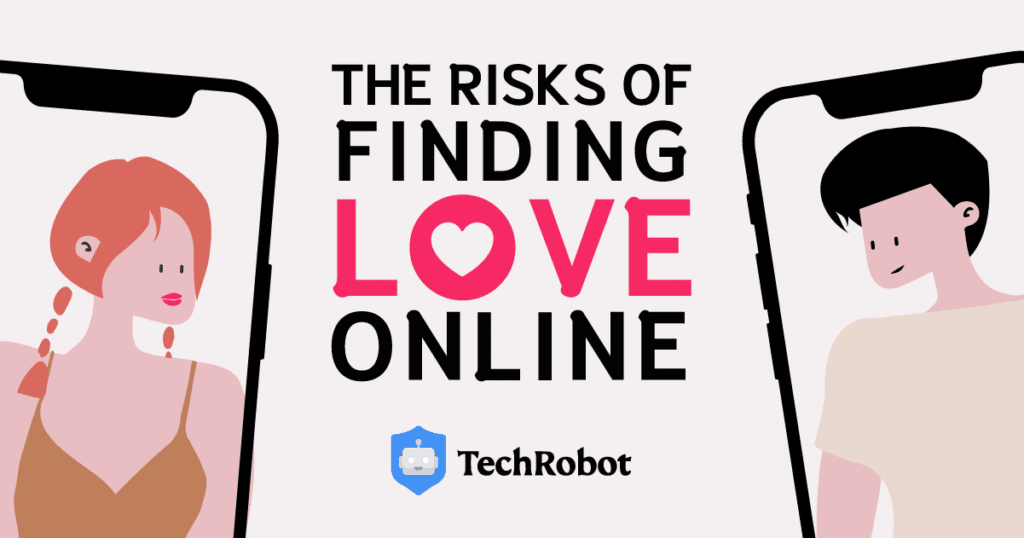
In recent years there has been a surge in the number of people looking for love online. Almost 300 million people use online dating platforms across the world and in 2021 alone over 260 million dating apps were downloaded (Business of Apps).
Many people do have honest intentions when using dating apps to find a potential partner, however, over half (53%) of users lie on their profiles (eharmony). Whilst in most cases the lies people tell on dating apps are innocuous attempts to appear more attractive – such as upping their height – there are many examples of people posing as prospective partners for nefarious reasons. For example, North East Police have linked hundreds of crimes to popular dating sites, including stalking offences and blackmail cases, one of many frightening reminders that oversharing on your dating profile can have negative consequences.
To reveal just how much information people share on dating apps and the risks associated with this, TechRobot has analysed 60 profiles on Tinder, Bumble, and Hinge. The study looked at how information sharing on dating profiles differs depending on the app and also across gender and sexuality.
Bumble Users Share The Most Personal Information On Their Profile
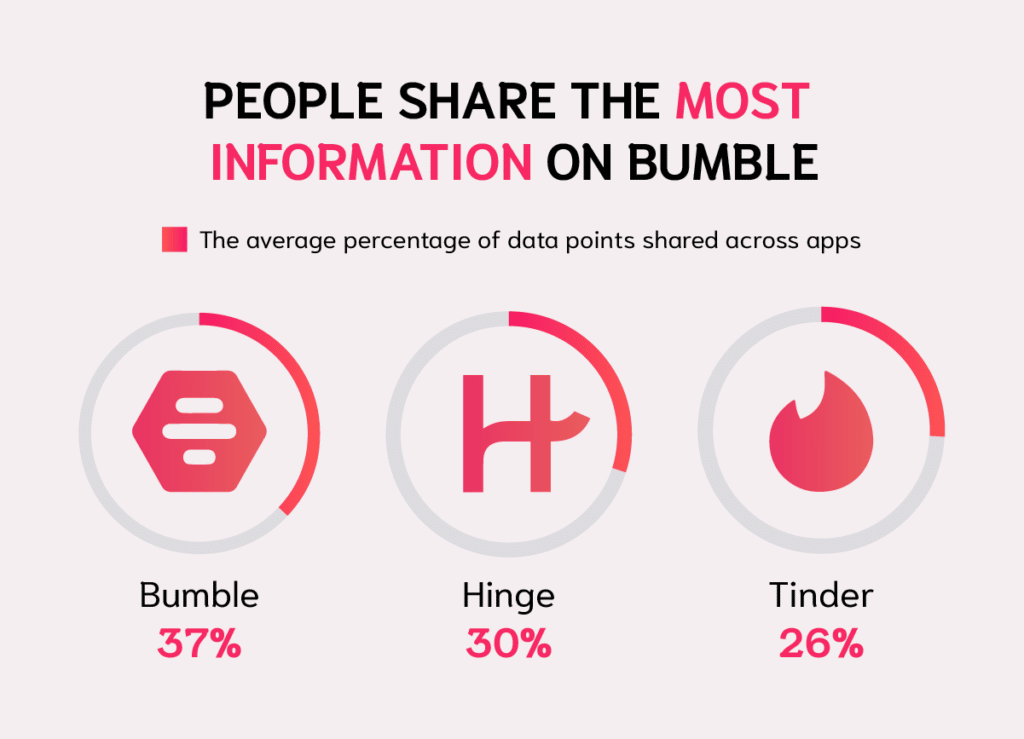
| The average percent of all data points that the 60 profiles we looked at share information on | |
| Bumble | 37% |
| Hinge | 30% |
| Tinder | 26% |
Based on the average number of daily visitors Tinder, Hinge, and Bumble are the most popular dating apps. We analysed 60 profiles on these apps across the following categories; straight men, straight women, gay men, and lesbian women, to reveal how personal information sharing differs based on our demographics and the apps we use.
Our research found that online daters are sharing the most personal information on Bumble. Across the 60 profiles analysed Bumble users share nearly 40% of all possible data points. Bumble encourages as much information sharing as possible, their site states ‘the more content you have [on your profile], the more likely your matches will have something thoughtful to say to you.’ This is likely why people share more information on this app than on any other. However, while opening up about who you are online might improve your chances of achieving a match, it could also put you at serious risk.
Sharing too much information on your dating profile could put you at risk of being stalked
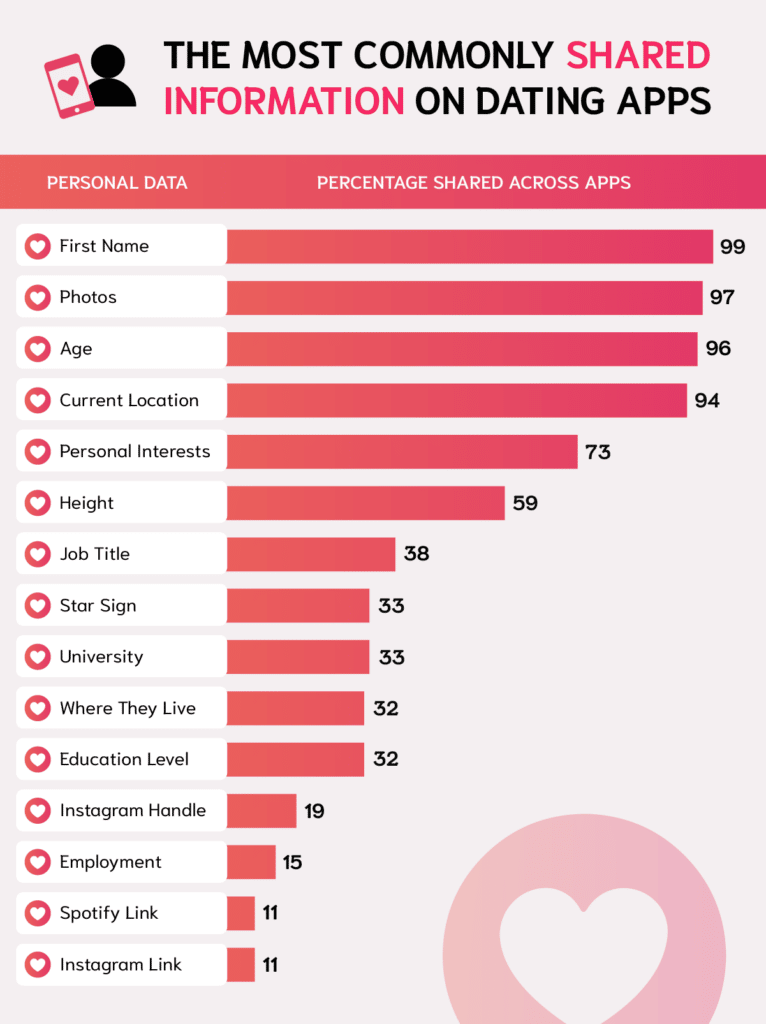
Unsurprisingly, all of the Bumble profiles analysed share their first name, age and current location, and 98% share photos of themselves. This is standard log in information required when you set up a Bumble profile to keep your account secure and help connect you to other local users.
However, there is no option to hide this information, in particular, your location and whilst your exact location is not disclosed, an estimated distance of how far away you are from a potential match is shown. If you engage with someone for a prolonged time on the app and they consistently check your current location it would be very easy for them to track your daily schedule and where you go.
Moreover, 90%, of all Bumble profiles share their personal interests and hobbies, 55% share where they live, 28% of all Bumble profiles we analysed share job titles, and 20% of Bumble profiles also share their Instagram handle. This is more than enough information for someone to have an insight into what you are doing throughout your day, and where you are, which could put you at serious risk of stalking.
Crimes such as stalking and catfishing are the most common dating app-related crimes. The BBC revealed that 37% of women have experienced some form of stalking after using a dating platform and there are multiple examples of this reported in the media including a recent Vice article on how a woman was approached face-to-face by a man who matched with her on Tinder and stalked her because she ignored his messages.
The following table shows how many of the 60 Bumble profiles analysed share information on personal data points:
| Personal Data Collection Point | Percentage of profiles that share data on this metric Bumble (%) |
| First Name | 100 |
| Age | 100 |
| Current location/ Distance from you | 100 |
| Photos / What they look like | 98 |
| Personal Interests | 90 |
| Where they live | 55 |
| Job title | 28 |
| Instagram handle | 20 |
| Employment/ Company | 15 |
Tinder’s privacy and security features make it the safest dating app analysed
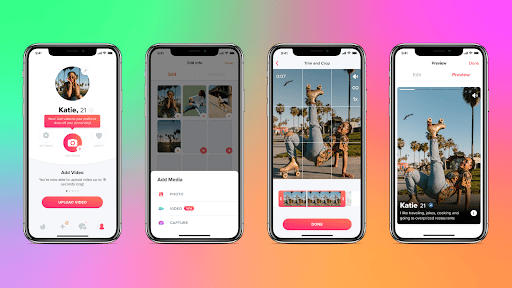
Of the three most popular dating apps analysed users share the least personal information on Tinder, on average a profile shares just 26% of all possible data points. This is most likely because Tinder discourages oversharing by offering a higher level of privacy features and security settings than the other top dating apps. Tinder premium subscribers can hide their current location and the app has introduced a new photo verification feature available to all users. If you take a live photo of yourself, the app will compare it against your uploaded photos to ensure that they match and a blue tick will appear on your profile to show you have completed this. Features like these reduce the possibility of fake dating profiles and the ability to keep tabs on other users, preventing catfishing and stalking.
It’s likely that people also share less information on Tinder because it offers fewer prompts and requirements when setting up your profile. For example, on Hinge, you need to add your height because this is a preference that other users can set as a ‘dealbreaker’ meaning if you fail to meet their requirements your profile won’t be visible to them. Tinder’s lack of requirements and prompts is because this platform aims to be as inclusive as possible. Tinder outlines that they don’t “filter based on height, education, race or religion, because demographics do not define a person. We believe everyone deserves the right to be seen and make the first move no matter how they identify.”
Women are more likely to be catfished and men blackmailed on dating apps
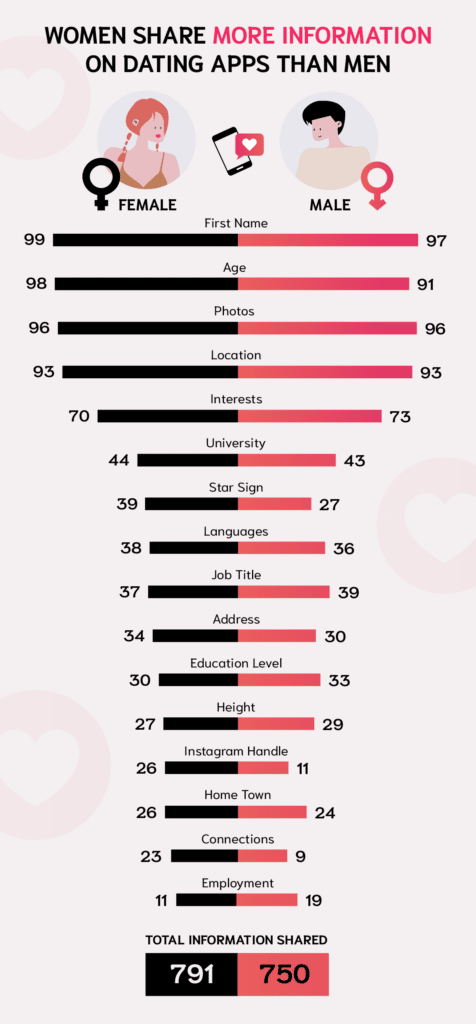
To gain a deeper insight into how information sharing on dating apps varies based on gender we compared male and female profiles across the top three dating apps. Our research found that women share an average of 33% of possible data points across Tinder, Bumble, and Hinge compared to men who share 31%. In fact, according to Datingroo expert Liina Edun, women are generally more likely to fall for romance scams and overshare information, particularly women between the age of 35 and 54.
Our analysis found that 39% of men share their job title, 36% the languages they speak, 19% their employer, and 33% their education level. Essentially men share a high proportion of information on their status, education level, and work life. Psychological studies into how we select sexual partners found women tend to place more value on ‘resource acquisition’ (Cambridge Core) and that women prefer men with higher incomes (Yale). This could explain why men choose to share a high level of information that outlines their ability to provide, their intelligence and their social status.
On the other hand, women tend to share information that makes them seem more physically attractive – 98% share their age, 96% share photos of what they look like and 26% share their Instagram handle. The Cambridge Core study also found that characteristics signalling ‘reproductive capacity’ are valued higher by men than women. Essentially men prefer attractive, younger mates that signal cues of fertility. Therefore, it’s likely that women share the information which displays their physical appearance to heighten their chances of being regarded as attractive and matched.
With women sharing more information on their physical appearance the risk of them being impersonated by a catfish is exacerbated. Over a quarter of women share their Instagram handle and 100% provide enough information for their other social media accounts to be found, this means the chances of a cybercriminal being able to create a convincing online profile and pose as them to potential matches is very high. In 2017, a woman was the victim of a catfish scam where her face was photoshopped onto model Jess Hunt’s body. As a result, she received abuse from strangers as they believed she was behind the catfishing stunt, when in fact it was a hacker who was attempting to match with others under false pretences.
Contrastingly, the information that men share about their job title and employer means they are more likely to be victims to blackmail attempts. If a scammer effectively lures a man into sending indecent photographs or sensitive information they are at risk of being bribed. Cybercriminals will often offer inducements for monetary gain and use sensitive information such as your workplace or contact list to leverage this. A recent survey has found this is a huge concern among people using apps – 57% of online daters are worried that the information they share will be used in a blackmail attempt and 6% said they were worried it would be used to damage their reputation at work (Kapersky). You should therefore be mindful of the content you are sending people online and only share sensitive information, such as your employer, with people you know.
The following table shows how many of the total male and female profiles across Tinder, Bumble, and Hinge share information on personal data points:
| Data point | Percentage of male dating app profiles across Tinder, Bumble, and Hinge that share information on this data point (%) | Percentage of female dating app profiles across Tinder, Bumble, and Hinge that share information on this data point (%) |
| Age | 91 | 98 |
| Job title | 39 | 37 |
| Languages spoken | 36 | 38 |
| Education level | 33 | 30 |
| Employment/ Company | 19 | 11 |
| Instagram handle | 11 | 26 |
LGBTQ+ daters experience more sextortion on dating apps than straight users

When analysing profiles across Tinder, Bumble, and Hinge, we also filtered by the following four sexual orientations- straight men, straight women, lesbian women, and gay men to see if sexual preference affects the amount of personal information people are sharing.
Our research found that homosexual online daters are more likely to share information on their future prospects, such as their plans for having children, and their dating intentions than heterosexual online daters. In line with this, a recent survey has found that 20% of LBTQ+ daters have been in a committed relationship with, or married someone from a dating app, compared to just 11% of straight users. Whether you are gay or straight, this suggests sharing information about your dating intentions will make you more likely to meet a partner whose values align with your own and therefore be able to build a stronger commitment.
The same survey found that LGBTQ+ people are twice as likely to use a dating app than straight people- 55% of LGBTQ+ adults say they have used one compared to just 28% of straight people. This could explain why they share more personal information on their profiles, as it is a primary method of meeting potential love interests. For example, our research found that on average 28% of homosexual profiles share where they live compared to just 19% of heterosexual profiles and that 98% of lesbian and gay dating profiles share what they look like, compared to 93% of straight profiles.
Sharing too much information poses a serious privacy risk, especially for the LGBTQ+ community, as they can not only be victims of blackmail and stalking attempts but also hate crimes and violent acts from homophobic people. The US Federal Trade Commission (FTC) has recently warned of scammers targetting the LBGTQ+ community through dating apps and a survey by Cyber Civil Rights has found that LGBTQ+ people are three times more likely to be victims of sextortion attempts than straight individuals.
The following table shows the average amount of personal information different profiles are sharing across Tinder, Bumble, and Hinge on the personal data:
| Personal Data Collection Point | Average percent of straight male profiles that share this info across all three apps (%) | Average percent of straight female profiles that share this info across all three apps (%) | Average percent of lesbian female profiles that share this info across all three apps (%) | Average percent of gay male profiles that share this info across all three apps (%) |
| Dating intentions | 20 | 18 | 31 | 27 |
| Children | 11 | 4 | 20 | 13 |
Lesbian women share the most information on dating apps
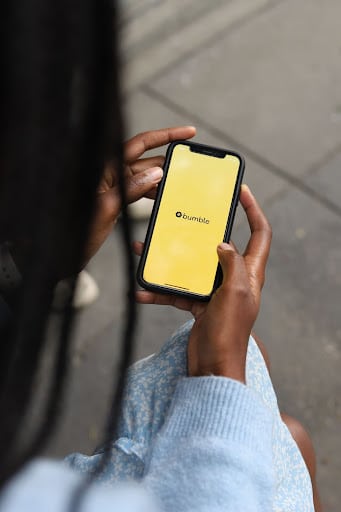
Our research found that lesbian women share the most information on their dating profiles and the app they share the most information on is Bumble- lesbian women share an average of 42% of all possible data points on their Bumble profiles. This compares to straight men who share the least, just 30% of all possible data points across all three apps.
All lesbian profiles on Bumble share their live location and age and 98% share their first name and photos of themselves. Further 69% share information on their personal interests, 44% where they live, and 36% their job title. Collectively, this means lesbian women are providing strangers on dating apps with a huge insight into their personal lives which could heighten their risk of being stalked, or even harassed. This issue is particularly exacerbated by the societal stigma the LGBTQ+ community faces. One woman told the Declan Herald she still encounters many men masquerading as women on apps like Tinder and some people even offer conversion therapy.
Dating apps are trying to be more inclusive and ensure that the LGBTQ+ community has the same experience on their platforms as others. Tinder has updated the app to include 37 gender options and CEO Sean Rad has said, “We’re really excited about the update and believe it is the right step to take as a company. Everyone is welcome on Tinder.” (Wired) Tinder has also introduced a travel feature where LGBTQ+ users are warned if they travel to a country where their dating preferences could have legal consequences. The ‘traveller alert’ can automatically hide their profiles to protect them against law enforcement and at the minimum conceal their gender and sexual oritenation.
The following table shows the average amount of personal information profiles are sharing across Tinder, Bumble, and Hinge:
| Sexuality | Average percent of data shared across all apps (Tinder, Bumble, and Hinge) % |
| Lesbian Women | 33 |
| Gay Men | 32 |
| Straight Women | 31 |
| Straight Men | 30 |
How to reduce your vulnerability when dating online
Whilst the amount of personal information we share on our dating profiles is dependant on the app, our gender, and sexual orientation, all profiles expose enough information to offer strangers a huge insight into our lives. This puts our identity, and safety, at risk and exacerbates our chances of being victims of crimes like blackmail, stalking, catfishing or harassment.
To make use of the selection of dating apps available, but also protect your privacy and safety, it’s important to be mindful of the information you share and make publicly available. Our VPN expert Lasse Walstad recommends the following steps to safely navigate the online dating world:
Wait to share personal information
Never share personal information that is sensitive, such as bank details or your home address, with someone over a dating app. If someone asks for information you are not comfortable with sharing report their profile and block them- if someone is using a dating app for the right reasons they will not ask for such information.
Use different photos on your dating profile
Using reverse image searching on Google, people will be able to find out your social accounts and any other places that your photos are posted giving them potential access to a large amount of personal information and your social accounts. Using images that you have not used on your other social accounts will ensure that you can reduce the chances of your other accounts, such as Instagram and Facebook, being less likely to be found.
Using a VPN
Using a VPN will spoof your location, meaning that apps that require your live location to function (such as Hinge and Tinder) will not reveal where you actually are to potential matches. However, as Tinder works using GPS you should note that doing this will mean that you will begin to see matches in the location that you set your VPN to. For example, if your VPN is set to California you will begin to see matches here. However, you can always set a location which is near your home but not your exact location to ensure you see relevant potential matches and also keep your location private.
Go on a date in public
If you have agreed to go on a date with someone who you have met on an online app make sure you meet in a public place. This ensures that if they are not who they said they were, have wrong intent, or they act suspicious you can get help easily or leave the situation with the help of others. Many bars and clubs also offer an ‘ask Angela’ service where if you are with someone who is making you uncomfortable you ask for Angela at the bar and they can safely sort you a taxi or help you leave the situation.
Sources and methodology
Based on the dating apps with the highest number of average active daily users in September 2021, we were able to determine the three most popular online dating apps.
Using this we then analysed 60 profiles across Tinder, Bumble and Hinge- 15 profiles per category: heterosexual men, heterosexual women, homosexual men, and homosexual women. Please note for all the dating apps the age range was set to 18-30 and the distance was set to 50 miles from the UK postcode KT.
The first 15 profiles that appeared after selecting the sexual orientated and gender of the profile were then analysed and we collected all the data they share on their profile out of all the potential data points for each app. The results were then compared based on the app, gender, and sexuality of the profiles to allow us to reveal how personal data sharing differs depending on demographic and the app.
- www.ofcom.org.uk/__data/assets/pdf_file/0023/238361/online-nation-2022-report.pdf
- play.google.com/store/search?q=tinder&c=apps
- play.google.com/store/search?q=bumble&c=apps
- play.google.com/store/search?q=hinge&c=apps
- www.businessofapps.com/data/dating-app-market/
- www.eharmony.com/online-dating-statistics/
- www.thenorthernecho.co.uk/news/20250420.durham-police-explain-dangers-using-dating-apps/
- saferdate.co.uk/datings-dangerous-secrets/
- www.vice.com/en/article/z3e5dj/i-was-stalked-by-tinder-date
- tinder.com/en-GB/about-tinder
- www.cambridge.org/core/journals/behavioral-and-brain-sciences/article/sex-differences-in-human-mate-preferences-evolutionary-hypotheses-tested-in-37-cultures/0E112ACEB2E7BC877805E3AC11ABC889
- economics.yale.edu/sites/default/files/files/Workshops-Seminars/Industrial-Organization/hortacsu-050908.pdf
- pewresearch.org/internet/2020/02/06/the-virtues-and-downsides-of-online-dating/
- bumble.com/en/about
- www.shemazing.net/womans-catfishing-ordeal-goes-viral-after-major-photoshop-fail/
- www.kaspersky.com/blog/online-dating-report/
- www.openaccessgovernment.org/sextortion/128564/
- www.deccanherald.com/metrolife/metrolife-cityscape/women-face-homophobia-even-on-datingapps-for-homosexual-768625.html
Related Posts
- The Best VPN Services (Updated: 2024)
- The Best VPN for Accessing Hinge – Date Securely
- The Best VPN for Accessing OnlyFans – Safe & Secure
- The Best VPN for Accessing Tinder – Date Securely
- How Much Do Game Developers Know About You?
- The Security Risks of Dining Out
- Which Governments Are Requesting Your Data The Most?
- How Many “Fake” Followers Do Instagram’s Top Celebrities And Brands Have?